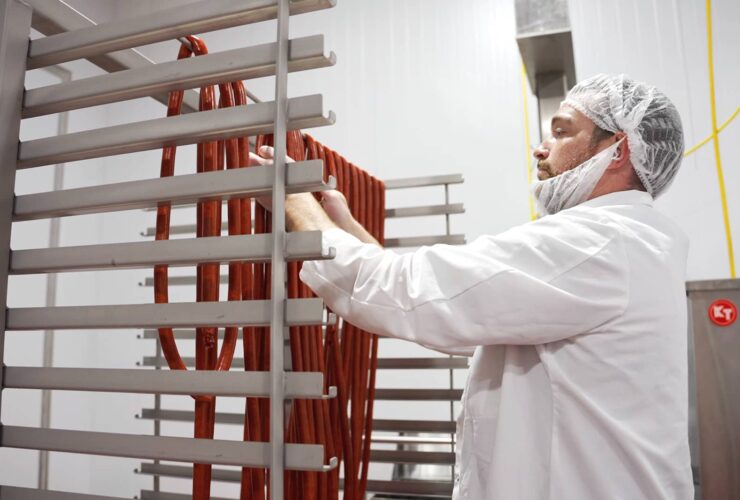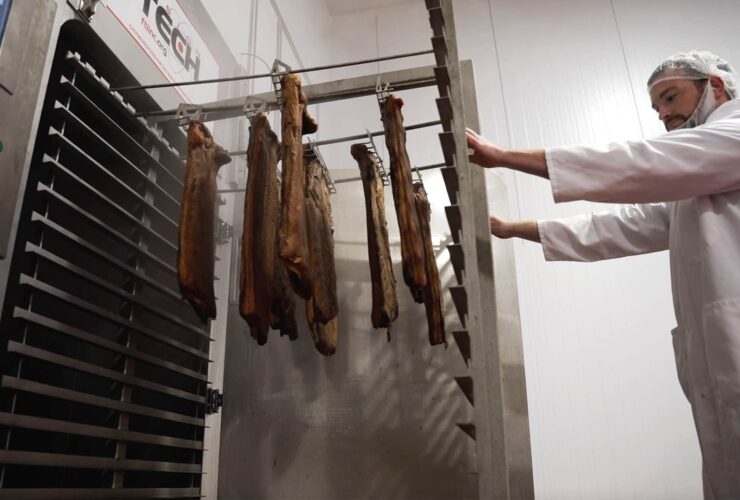Smokehouse Breakpoint. If you work with industrial smokehouses, or are in the market for one, you’re likely familiar with the term. It is the most important factor in your smokehouse, after all.
But what exactly is the smokehouse breakpoint? How does it form? Why is it so important? How does it affect your product?
Even those in the business of cooking and drying product, or purchasing smokehouses for their company, have trouble answering those questions.
If the breakpoint really is the most important factor in your smokehouse (and you’ll see below, it really is!), then it’s imperative to understand what exactly the breakpoint it and how it affects your product.
The Ultimate Smokehouse Breakpoint Guide
In order to help you better understand the smokehouse breakpoint and how it affects your product, we put together this easy to understand guide complete with explanations and pictures that move away from the technical jargon.
The Breakpoint Guide is quite lengthy, but you can skip to the section you want by clicking the links below.
- What is the Breakpoint
- Forming the breakpoint
- Movement of the Breakpoint
- How the Breakpoint Cooks Product
- Rack Design & Breakpoint
- How the Breakpoint Affects Product Consistency
- Controlling the Breakpoint
What is the Smokehouse Breakpoint?
Back in the late 1950’s, an innovative new way of cooking product in the meat processing industry was discovered — an innovation that is still in use in industrial smokehouses and dehydrators today.
This innovation incorporated the use of alternating dampers in forced-air ovens so air from a single fan could be delivered to product on racks.
The alternating dampers on either side of the oven create two opposing airstreams in the oven cabinet. The location where these opposing airstreams collide is called the breakpoint.
Forming the Smokehouse Breakpoint
The breakpoint is formed by a combination of the fan, alternating dampers, and the corresponding high and low velocity airflows created in the oven.
Airflow created by the fan enters the supply duct and hits the alternating dampers. The damper that is set to block the duct creates the low velocity airflow while the damper set to open creates the high velocity airflow. These differing airflows are on opposing sides of the oven, as seen in the image below.
[av_image src=’https://ftiinc.org/wp-content/uploads/2016/05/smokehouse-breakpoint.jpg’ attachment=’10865′ attachment_size=’full’ align=’center’ styling=” hover=” link=” target=” caption=” font_size=” appearance=” overlay_opacity=’0.4′ overlay_color=’#000000′ overlay_text_color=’#ffffff’ animation=’no-animation’ custom_class=” av_uid=’av-1w73ai8′][/av_image]
The high velocity airflow travels down the oven wall, across the floor, and up the opposing side. The low velocity airflow travels a much shorter distance, hence being low velocity.
The collision of the low velocity airflow and the high velocity airflow causes the air to break towards the center of the oven — forming the breakpoint.
When formed correctly, the breakpoint has enough velocity to penetrate through the product on your rack before the air is drawn back to the return duct. It’s this breakpoint air that ultimately cooks your product.
Movement of the Smokehouse Breakpoint
An efficient smokehouse or dehydrator doesn’t rely on just one or two breakpoints to cook the product. Doing so creates cold spots within the oven (areas where product is not getting enough of the breakpoint air to cook correctly) and results in product inconsistencies — both in yields and coloring.
The ability to move the breakpoint to various zones allows for more uniform cooking.
The breakpoint needs to be positioned at the height of the product, not too high, which bypasses the product envelope, and not too low that it is not directing airflow to the upper corners of the product envelope.
Adjusting the angle of the dampers allows more or less airflow into the oven cabinet. As the dampers adjust, the velocity of the air released changes — either increasing or decreasing the high velocity airflow to go further or less in the oven. When the airflows change velocity, the point where they collide (the breakpoint) changes locations in the oven.
[av_image src=’https://ftiinc.org/wp-content/uploads/2016/05/smokehouse-breakpoint-movement.jpg’ attachment=’10866′ attachment_size=’full’ align=’center’ styling=” hover=” link=” target=” caption=” font_size=” appearance=” overlay_opacity=’0.4′ overlay_color=’#000000′ overlay_text_color=’#ffffff’ animation=’no-animation’ custom_class=” av_uid=’av-1s66dv4′][/av_image]
The speed at which the breakpoint moves is dependent upon the damper shaft’s revolution per minute.
In order to get good heat transfer and enough exposure to the oscillating airflow for even drying of product, the RPM of the supply airflow dampers should run between 0.25 and 0.5 RPM, or its equivalency if the dampers move back and forth from 0 degrees to 90 degrees.
How the Breakpoint Cooks Product
As already mentioned, it is the air in the breakpoint that actually cooks your product.
The velocity of the breakpoint air as it moves across product on the rack essentially wipes away a layer of cold air surrounding the product and replaces it with hot air. The hot air left behind is eventually transferred to the product, cooking it to the required temperature.
Rack Design and Breakpoint
The design of the rack used in the smokehouse can greatly affect airflow in the oven, and hinder the formation of the breakpoint.
As mentioned above, the high velocity airflow travels down the wall of the oven and across the floor to meet the low velocity airflow. In other words, it must travel under the rack in the oven.
Any obstructions in the path of the high velocity airflow can slow down or stop the airflow.
A smokehouse rack designed with a low clearance (image 1 below) will cause an airflow obstruction in the oven. This low design essentially creates a “wall” on the floor of the oven, breaking the high velocity airflow and affecting where the breakpoint occurs.
[av_image src=’https://ftiinc.org/wp-content/uploads/2016/04/smokehouse_truck_design-2.jpg’ attachment=’10826′ attachment_size=’full’ align=’center’ styling=” hover=” link=” target=” caption=” font_size=” appearance=” overlay_opacity=’0.4′ overlay_color=’#000000′ overlay_text_color=’#ffffff’ animation=’no-animation’ custom_class=” av_uid=’av-1bx800g’][/av_image]
In order to keep the high velocity airflow from being obstructed, the rack should have minimal obstructions up to 12 inches from the floor (image 2 below).
How the Breakpoint Affects Product Consistency
The breakpoint plays a critical role in the consistency of your product and is often to blame for poor product yields (or the remaining weight of your product after cooking).
Most smokehouses offer only a handful of breakpoint locations in the oven — meaning product closest to those breakpoints get cooked faster and more thoroughly, while product furthest from the breakpoints cooks slower.
The varying rates of cooking caused by fewer breakpoints in the oven leads to higher yield gaps: where some product on your rack is over cooked and other product is cooked just right.
As you have likely experience, this results in inconsistent product yields and coloring. The product closest to the breakpoint often can be burnt, darker, and in some cases, needs to be thrown out, while product furthest from the breakpoint achieves the color desired.
[av_image src=’https://ftiinc.org/wp-content/uploads/2016/05/smokehouse-breakpoint-consistency.jpg’ attachment=’10867′ attachment_size=’full’ align=’center’ styling=” hover=” link=” target=” caption=” font_size=” appearance=” overlay_opacity=’0.4′ overlay_color=’#000000′ overlay_text_color=’#ffffff’ animation=’no-animation’ custom_class=” av_uid=’av-2dssnk’][/av_image]
Imagine the difference in your product if there were more breakpoints in the oven! Rather than needing to overcook the product closes to the breakpoint so that product furthest from the breakpoint can be cooked, there would be more breakpoints — meaning less product would be away from the breakpoint.
When there are more breakpoints in the oven, you eliminate those cold spots and your product cooks more consistently.
Controlling the Breakpoint
When you understand the smokehouse breakpoint and how it cooks your product, it leads to one conclusion: controlling the breakpoint (i.e. – directing the airflows to break in certain zones in the oven) gives you ultimate control over your product.
Fusion Tech’s Total Flow Control system allows you to control the breakpoint in your smokehouse or dehydrator automatically — based on the internal temperature variance of your product — throughout the entire cooking process. Total Flow Control also allows you to pre-program the breakpoint by having complete control over your supply dampers, eliminating the temperature variances found in smokehouses.





